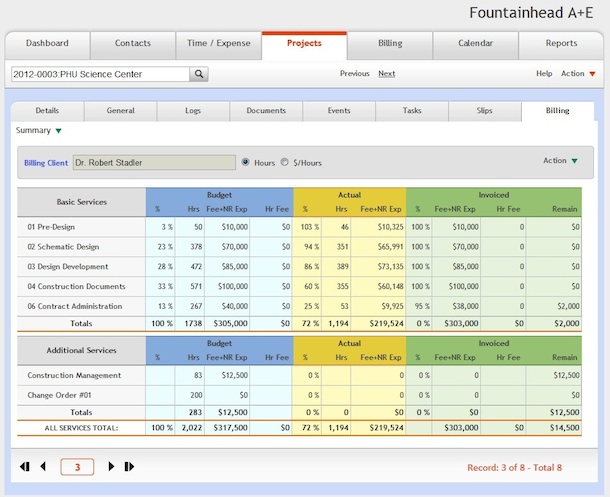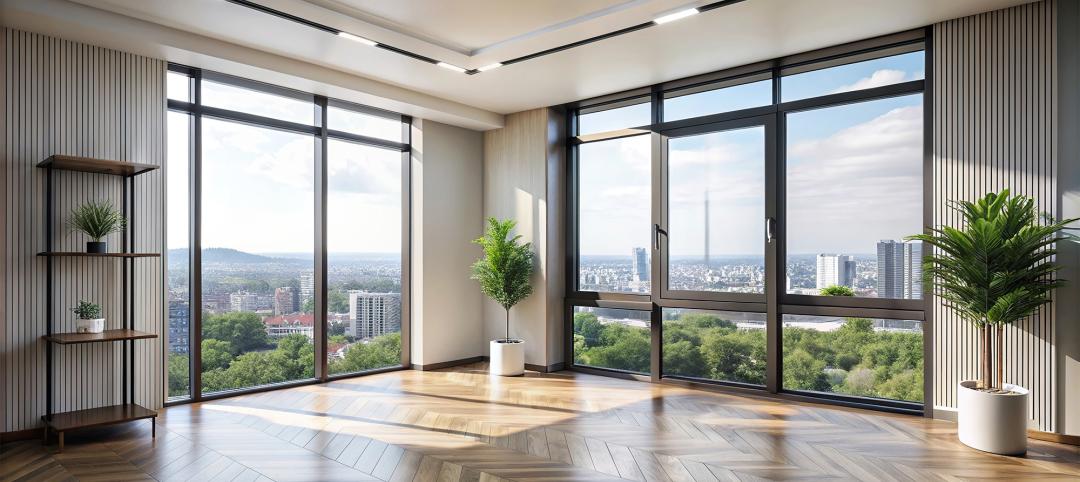They started with just 2 employees and a big dream—to be a premier high-end, multidisciplinary firm, able to provide clients with a full range of services. They wanted to meet and exceed the most discerning clients’ expectations and have Vertical Arts’ vision stamped on every aspect of production.
Since Vertical Arts opened its doors in ’05, they’ve been using ArchiOffice to handle billing and project management. They had fluctuations like everyone else during the roughest years of the recession, yet they’ve more than quadrupled their staff and have plans to expand even more in the coming years.
Their revenue has gone up 300-350% in eight years’ time. Their accountant has even started recommending ArchiOffice to neighboring firms.
They’re able to offer a full service architectural experience—coordinating surveyors, helping clients orchestrate moves or get home inspections done, and allowing consultant billing to come through them.
How Do They Do It?
They Invoice in Half a Day or So
Using ArchiOffice means they can get billing done for all their complex projects in half a day to a day. So all employees’ hours are always billable, and Parker, the company’s only administrative employee can tackle billing efficiently, getting on to his other responsibilities. “If we didn’t have ArchiOffice, we’d have to hire at least one more person, part or full time,” he admits. Instead, they can take on more jobs and projects because their staff isn’t tied up doing administrative work.
They Organize Projects Ridiculously Well
Parker explains: “We have one specific project that we’ve chosen to divide into with 9 sub-projects, so that we can individually track time and expense per sub-project. And ArchiOffice keeps that whole world organized for us. ArchiOffice allows us to manage more jobs and projects with still just one support staff member.”

Since Vertical Arts opened its doors, the firm has been using ArchiOffice to handle billing and project management. The firm can get billing done for their projects in less than a day.
Their Client Relationships are Rock Solid
“It streamlines our process and gives us access to tons of information and reports quickly so we don’t spend much time answering questions for clients—we just generate it and send it right back. I know our clients trust our billing and our process. It’s really strengthened our client relationships.”
They Became an Incredibly Impressive Firm
“Overall ArchiOffice is just a great billing and project management software—to be able to go to one place and see all your time, all your budgets, all your invoices and transactions, it just streamlines the administrative side significantly,” explains Parker.
Now, Vertical Arts doesn’t have to settle for taking on uninspiring projects. They do most of their work with a number of individual clients. They’ve achieved their dream of being a multidisciplinary high-end firm—they have an interior designer on staff, a landscape architect, as well as a full architectural team, so they’re able to provide the full range of services they know their clients deserve.
Learn more about ArchiOffice Software here.
Check out Vertical Arts Architecture here.
Related Stories
Multifamily Housing | Jun 14, 2024
AEC inspections are the key to financially viable office to residential adaptive reuse projects
About a year ago our industry was abuzz with an idea that seemed like a one-shot miracle cure for both the shockingly high rate of office vacancies and the worsening housing shortage. The seemingly simple idea of converting empty office buildings to multifamily residential seemed like an easy and elegant solution. However, in the intervening months we’ve seen only a handful of these conversions, despite near universal enthusiasm for the concept.
Healthcare Facilities | Jun 13, 2024
Top 10 trends in the hospital facilities market
BD+C evaluated more than a dozen of the nation's most prominent hospital construction projects to identify trends that are driving hospital design and construction in the $67 billion healthcare sector. Here’s what we found.
Adaptive Reuse | Jun 13, 2024
4 ways to transform old buildings into modern assets
As cities grow, their office inventories remain largely stagnant. Yet despite changes to the market—including the impact of hybrid work—opportunities still exist. Enter: “Midlife Metamorphosis.”
Affordable Housing | Jun 12, 2024
Studio Libeskind designs 190 affordable housing apartments for seniors
In Brooklyn, New York, the recently opened Atrium at Sumner offers 132,418 sf of affordable housing for seniors. The $132 million project includes 190 apartments—132 of them available to senior households earning below or at 50% of the area median income and 57 units available to formerly homeless seniors.
Mass Timber | Jun 10, 2024
5 hidden benefits of mass timber design
Mass timber is a materials and design approach that holds immense potential to transform the future of the commercial building industry, as well as our environment.
Lighting | Jun 10, 2024
LEDs were nearly half of the installed base of lighting products in the U.S. in 2020
Federal government research shows a huge leap in the penetration of LEDs in the lighting market from 2010 to 2020. In 2010 and 2015, LED installations represented 1% and 8% of overall lighting inventory, respectively.
Industrial Facilities | Jun 8, 2024
8 ways to cool a factory
Whichever way you look at it—from a workplace wellness point of view or from a competing for talent angle—there are good reasons to explore options for climate control in the factory workplace.
Education Facilities | Jun 6, 2024
Studio Gang designs agricultural education center for the New York City Housing Authority
Earlier this month, the City of New York broke ground on the new $18.2 million Marlboro Agricultural Education Center (MAEC) at the New York City Housing Authority’s Marlboro Houses in Brooklyn. In line with the mission of its nonprofit operator, The Campaign Against Hunger, MAEC aims to strengthen food autonomy and security in underserved neighborhoods. MAEC will provide Marlboro Houses with diverse, community-oriented programs.
Office Buildings | Jun 6, 2024
HOK presents neurodiversity research and design guidelines at SXSW 2024
Workplace experts share insights on designing inclusive spaces that cater to diverse sensory processing needs.
Apartments | Jun 4, 2024
Apartment sizes on the rise after decade-long shrinking trend
The average size of new apartments in the U.S. saw substantial growth in 2023, bouncing back to 916 sf after a steep decline the previous year. That is according to a recent RentCafe market insight report released this month.

















